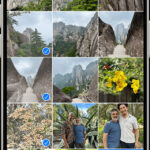Accidentally deleted precious photos from your Samsung Galaxy phone? Don’t panic! Many Samsung users believe lost photos are gone forever, but in most cases, they can be recovered. This guide explores multiple proven methods to recover deleted photos from Samsung devices, covering techniques that even seasoned users might not know.
These methods are applicable to virtually all Samsung phones, including the latest Samsung Galaxy S24, S23, S22, S21, S20, S10, Note 20, Note 10, and older models like the S9, S8, S7, and even S6 and S5.
Time is of the essence when it comes to photo recovery. The sooner you start the recovery process, the higher your chances of successfully retrieving your cherished memories. Let’s dive into the various ways you can get your deleted photos back on your Samsung Galaxy phone.
Recovering Samsung Galaxy Photos from Cloud Backups
One of the most convenient ways to recover deleted photos on a Samsung phone is through cloud backup services. If you’ve been using cloud storage, your photos might be safely stored there, even if they’re no longer on your device. Cloud recovery is device-agnostic, meaning you can restore photos even if your Samsung phone is lost, damaged, or inaccessible. For optimal speed and ease, we recommend using a computer with a stable internet connection for these methods.
Method 1: Restoring from Samsung Cloud Backup
Samsung Galaxy devices offer a built-in cloud service called Samsung Cloud, designed to back up your important data, including photos. If you had the Auto Sync feature enabled in your Gallery settings, your photos were likely automatically backed up to Samsung Cloud.
Note: This method only works if you had Samsung Cloud’s Gallery Auto Sync feature activated before the photos were deleted. If this feature was off, your photos were not backed up to Samsung Cloud.
Here’s How To Recover Deleted Photos From Samsung Cloud:
- Go to the Samsung Cloud website in a web browser.
- Log in using your Samsung account credentials.
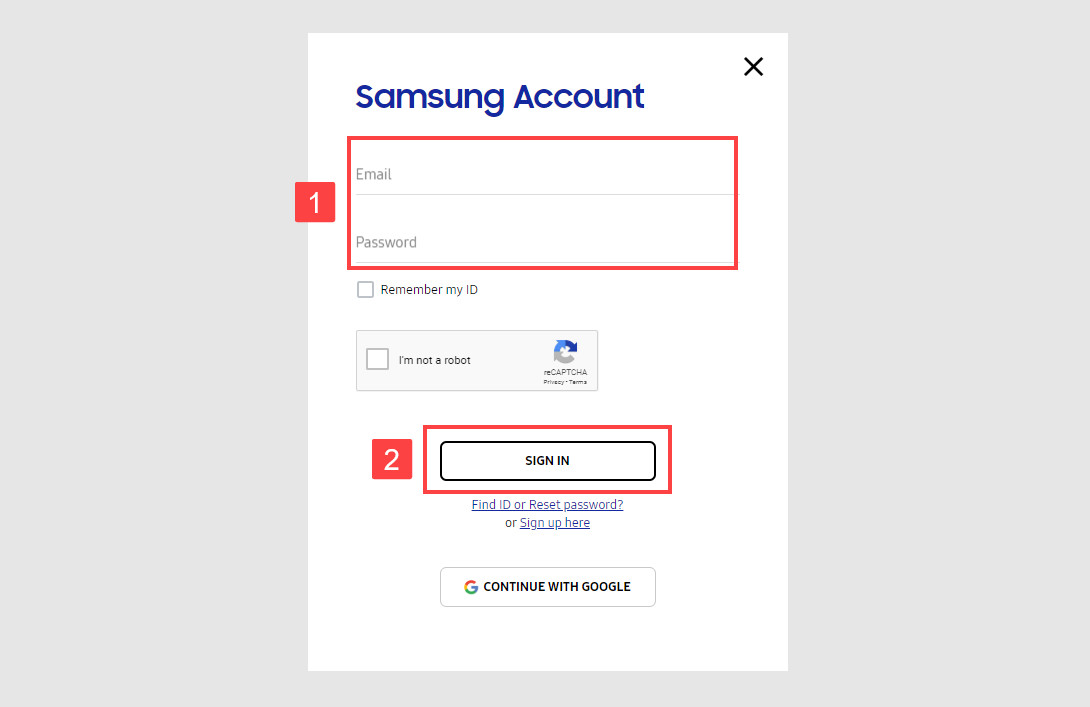 Samsung Cloud Login for photo recovery
Samsung Cloud Login for photo recovery - Click on Gallery.
- Review the photos in your Samsung Cloud Gallery backup. Select the photos you wish to recover individually, or select All to recover all backed-up images.
- Click the Download icon, usually located in the top right corner of the screen. Your selected photos will be downloaded to your computer, ready to be transferred back to your Samsung phone.
Method 2: Recovering Photos from Google Photos
Google Photos is a widely used cloud storage and photo management service pre-installed on most Android phones, including Samsung Galaxy devices. Google Photos offers free storage (with some compression) and automatically backs up your photos if you’ve enabled backup and sync.
Note: While the Google Photos mobile app allows downloading photos, it’s limited to one photo at a time. For bulk recovery, the web version is significantly more efficient.
Steps to retrieve deleted photos from Google Photos:
- Open Google Photos in your web browser.
- Sign in to your Google account – the same account you use on your Samsung phone.
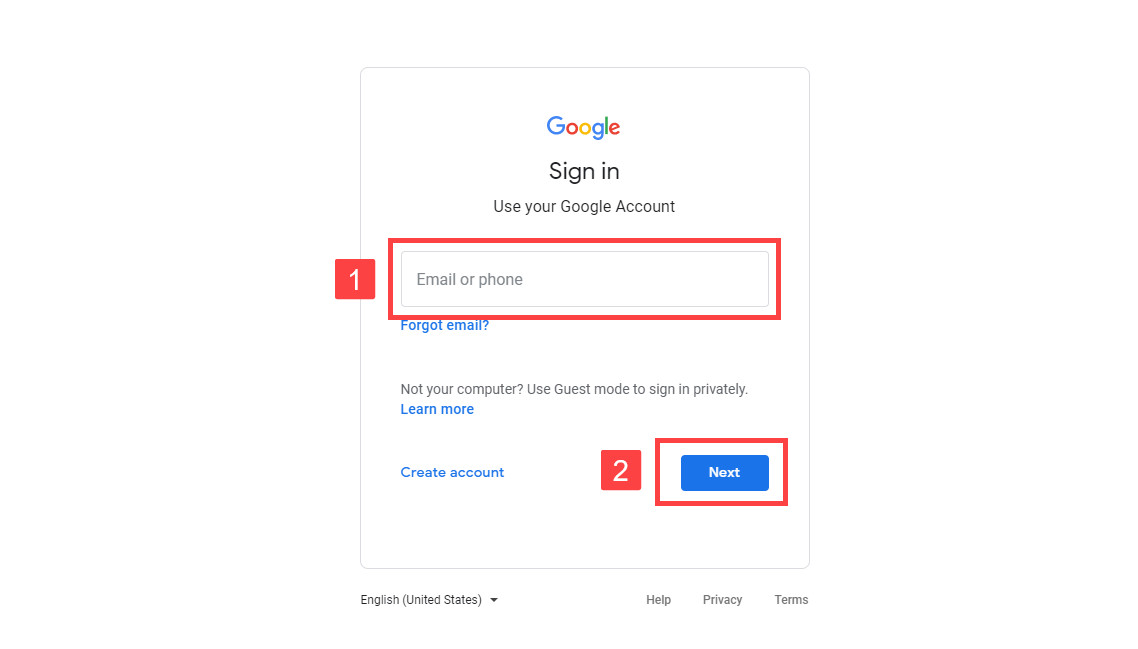 Google Photos login for Samsung photo recovery
Google Photos login for Samsung photo recovery - Carefully go through your Google Photos library. Hover over each photo you want to recover and click the checkmark in the top-left corner to select it.
- Once you’ve selected all desired photos, click the three-dot More options menu in the top-right corner.
- Choose Download. Google Photos will download the selected images as a ZIP file to your computer, which you can then extract and transfer back to your Samsung phone.
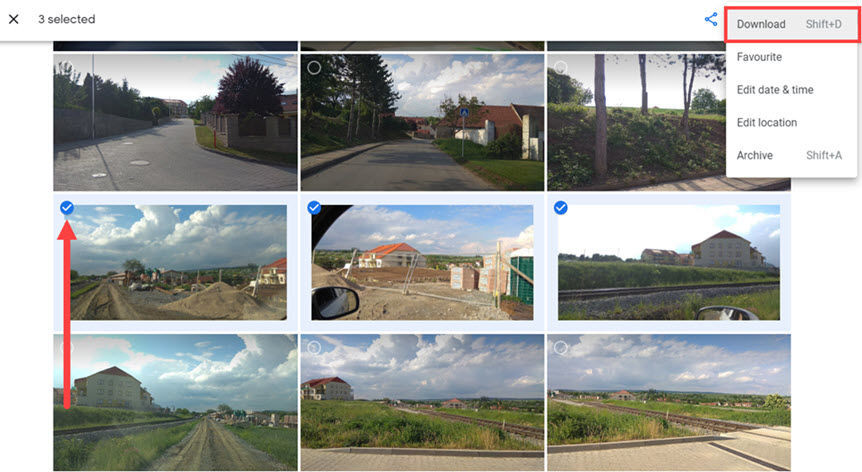 Downloading recovered photos from Google Photos to computer
Downloading recovered photos from Google Photos to computer
Method 3: Retrieving Photos from Microsoft OneDrive
Microsoft OneDrive is another popular cloud storage solution, especially for users within the Microsoft ecosystem. Many Samsung users utilize OneDrive for its integration with Windows and its auto-upload feature for photos and videos. If you use OneDrive, your deleted Samsung photos might be recoverable from the cloud.
Steps to recover photos from Microsoft OneDrive:
- Open the OneDrive website or the OneDrive app.
- Navigate to the Photos section, usually found in the navigation menu.
- Browse your OneDrive photo library. Select the photos you wish to recover.
- Click the three-dot More actions menu, often located in the top right or bottom right corner, depending on whether you’re using the web or app interface.
- Select the Save or Download option. In the OneDrive Android app, the option is typically Save. Your photos will be downloaded to your computer or saved to your phone’s local storage, depending on the platform you are using.
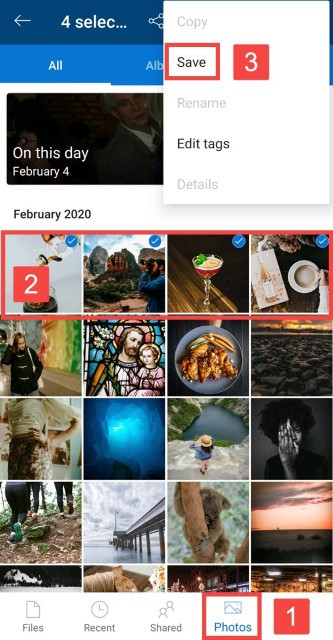 Saving recovered photos from OneDrive to a Samsung device
Saving recovered photos from OneDrive to a Samsung device
Method 4: Recovering Photos from Dropbox
Dropbox, while offering less free storage compared to some competitors, is a reliable cloud storage service favored by many Samsung Galaxy users. If you’re a Dropbox user, especially if you manually or automatically backed up your Samsung photos to Dropbox, recovery is possible.
Steps to recover photos from Dropbox:
- Launch the Dropbox app or go to the Dropbox website.
- Go to your Photos folder, or the folder where you typically save your Samsung photos within Dropbox.
- Select the photos you need to recover.
- Tap or click the three-dot More menu associated with your selection.
- Choose the Save to Device option in the app, or Download on the website. This will download the photos back to your Samsung phone or computer, respectively.
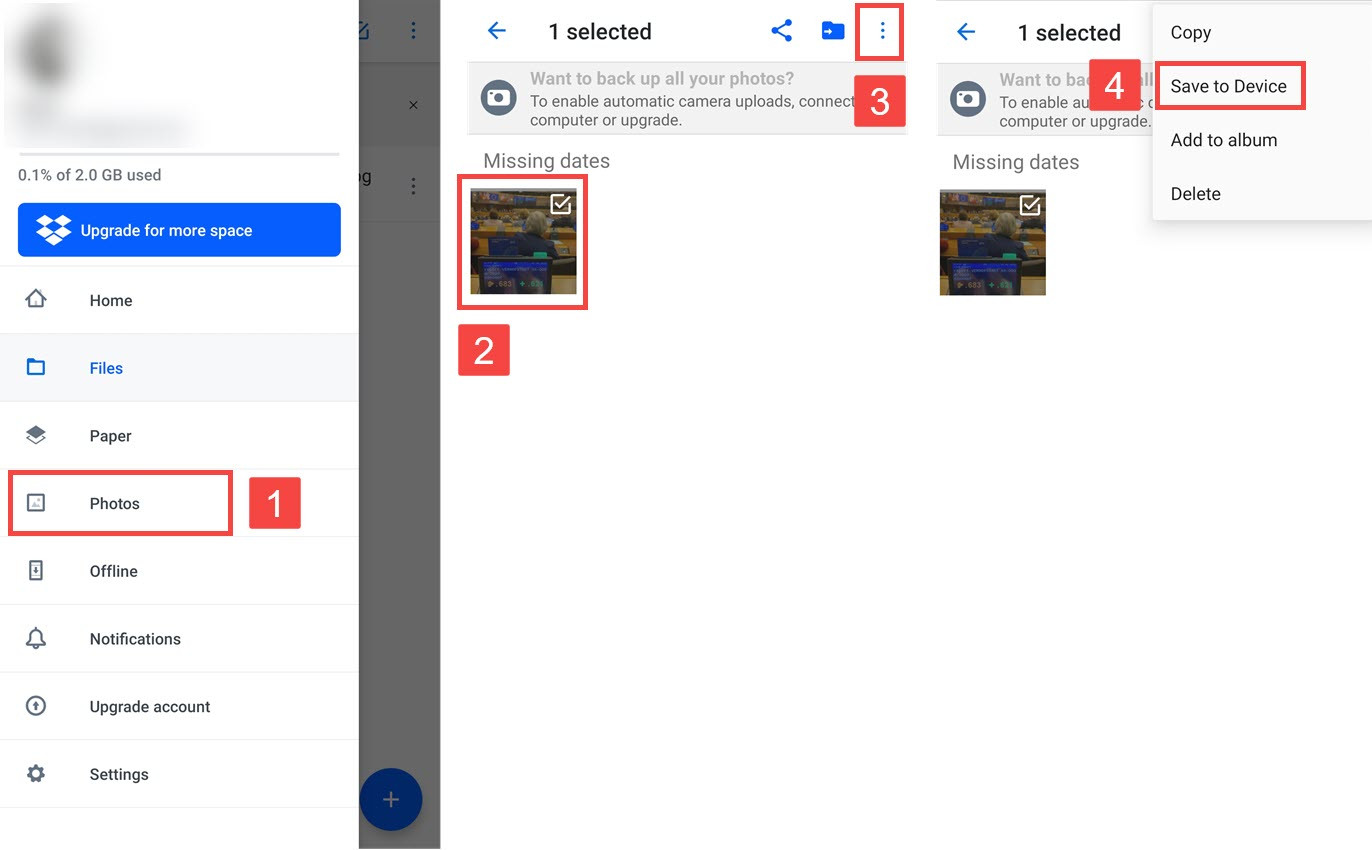 Downloading photos from Dropbox to recover on Samsung
Downloading photos from Dropbox to recover on Samsung
Method 5: Retrieving Photos from Google Drive
While Google transitioned its primary photo backup service to Google Photos in 2019, photos backed up to Google Drive before that change might still reside there. You can check Google Drive for older photos you might have backed up previously.
Note: Unlike Google Photos, Google Drive allows you to download multiple photos at once even in the mobile app. However, the web version provides easier navigation and selection for bulk recovery.
Steps to recover photos from Google Drive:
- Access Google Drive via a web browser.
- Locate the folder where your photos might be stored. This could be a folder you created or a general “Photos” or “Backup” folder.
- To select multiple photos, hold down the Ctrl key (or Cmd key on Mac) and click on each photo you want to recover.
- Once you’ve selected all desired photos, click the three-dot More actions menu, usually located at the top right of the screen.
- Select Download. Google Drive will compress the selected photos into a ZIP file and download it to your computer. Extract the ZIP file to access your recovered photos and transfer them back to your Samsung phone if needed.
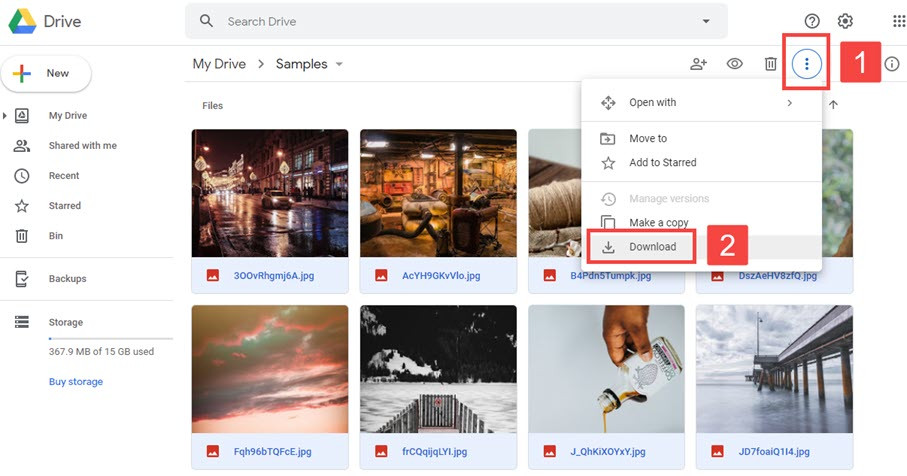 Downloading multiple photos from Google Drive website for recovery
Downloading multiple photos from Google Drive website for recovery
Recovering Deleted Photos from Samsung Internal Phone Memory
Before moving to more advanced methods, it’s crucial to understand the difference between photos disappearing from the Gallery app and actual photo deletion. Sometimes, photos might seem lost in the Gallery due to software glitches or accidental folder changes, not permanent deletion. In such cases, the photos are likely still present in your phone’s internal memory and easily recoverable.
Using File Management to Check Internal Memory:
You can use a file manager app (like Samsung’s “My Files” or Files by Google) or connect your phone to a computer to explore your phone’s internal storage. Look for folders like “DCIM” (Digital Camera Images), “Pictures,” or any custom folders where you might have stored photos. Sometimes, “deleted” photos are simply misplaced into a different folder.
Using SideSync to Access Samsung Phone Files from PC (Outdated Method – Consider alternatives):
Note: SideSync is an older Samsung application and may not be compatible with the latest Samsung devices and operating systems. Consider using Samsung Flow or simply connecting your phone via USB for file access.
If SideSync is compatible with your device, follow these steps:
- Download and install SideSync on your computer.
- Connect your Samsung Galaxy phone to your computer using a USB cable or ensure both devices are on the same Wi-Fi network.
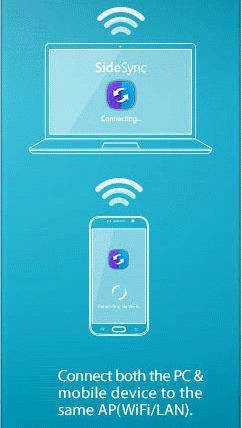 Connecting Samsung phone to computer using SideSync for photo recovery
Connecting Samsung phone to computer using SideSync for photo recovery - Launch SideSync on your computer.
- In the SideSync interface, select My Files. This will give you access to your Samsung phone’s file system from your computer.
- Navigate to the Images folder and check for your missing photos. If not found there, explore Device storage and meticulously check folders where your photos might be located.
- Once you locate the photos, simply drag and drop them to your computer desktop or any desired folder to restore them.
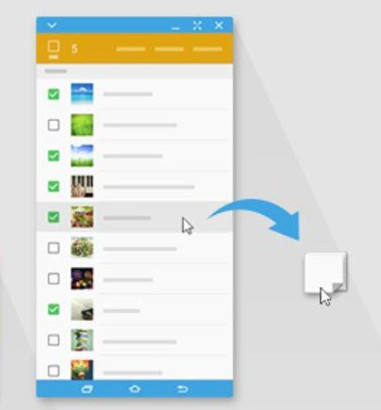 Recovering Samsung photos by dragging and dropping from SideSync
Recovering Samsung photos by dragging and dropping from SideSync
Recovering Deleted Photos from Samsung Recycle Bin (Trash)
The Samsung Gallery app includes a “Recycle bin” (sometimes called “Trash”) feature. When you delete a photo in the Gallery, it’s moved to the Recycle bin instead of being immediately permanently deleted. Photos remain in the Recycle bin for 30 days (or 15 days in some older versions) before permanent deletion.
Steps to restore photos from the Samsung Gallery Recycle bin:
- Open the Samsung Gallery app on your phone.
- Tap the three vertical dots (More options menu) usually located in the Pictures section or main screen of the Gallery app.
- Select Recycle bin (or Trash) from the options. This will open the Recycle bin folder containing recently deleted photos.
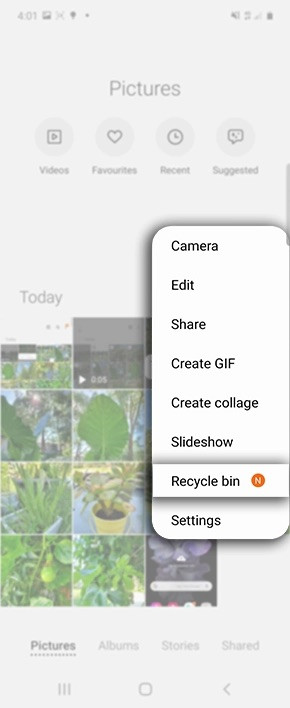 Selecting the Recycle bin option in Samsung Gallery for photo recovery
Selecting the Recycle bin option in Samsung Gallery for photo recovery - Review the photos in the Recycle bin. Select the photos you wish to restore by tapping and holding on them, or using the “Edit” or “Select” option to choose multiple photos.
- Tap the Restore button, typically located at the bottom of the screen. The selected photos will be restored to their original location in your Gallery.
 Restoring selected photos from Samsung Recycle bin
Restoring selected photos from Samsung Recycle bin
Recovering Permanently Deleted Photos from Samsung Galaxy (SD Card & Internal Memory)
If you’ve emptied the Recycle bin, or if the 30-day (or 15-day) period has passed, or if your photos were deleted before the Recycle bin feature was introduced (on older devices or if the feature was disabled), you’ll need to use specialized photo recovery software. This software can scan your Samsung phone’s internal memory or SD card for recoverable photo files.
Method 1: Using Photo Recovery Software for Mac (Disk Drill for Mac)
Disk Drill is a reputable data recovery software for macOS that can directly recover data from Android devices, including Samsung Galaxy phones. It can recover various image file formats like JPG, PNG, GIF, TIFF, and more.
Steps to recover deleted photos using Disk Drill for Mac:
-
Download and install Disk Drill for Mac. Drag the Disk Drill application icon to your Applications folder to complete the installation.
Alt text: Promotional banner with a “Free Download” button for Disk Drill data recovery software, emphasizing its capability for deleted file recovery.
-
Connect your Samsung Galaxy device to your Mac computer using a USB cable. Ensure your phone is set to USB file transfer mode (MTP). Allow Disk Drill to access your device when prompted on your phone.
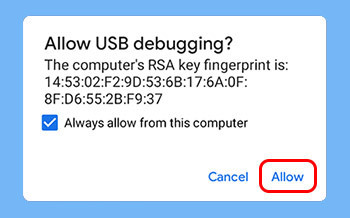 Connecting Samsung Galaxy phone to Mac for Disk Drill recovery
Connecting Samsung Galaxy phone to Mac for Disk Drill recovery -
Grant Disk Drill full access to your device. For optimal recovery from internal memory, your Samsung device might need to be rooted. Disk Drill will guide you through the rooting process or suggest alternative recovery methods if rooting is not desired.
 Granting Disk Drill access to Samsung device for photo recovery
Granting Disk Drill access to Samsung device for photo recovery -
Launch Disk Drill for Mac. In the Disk Drill interface, locate your Samsung phone under the Android Devices section. Select your device and click Search for lost data. Disk Drill will begin scanning your Samsung phone’s storage for recoverable photos.
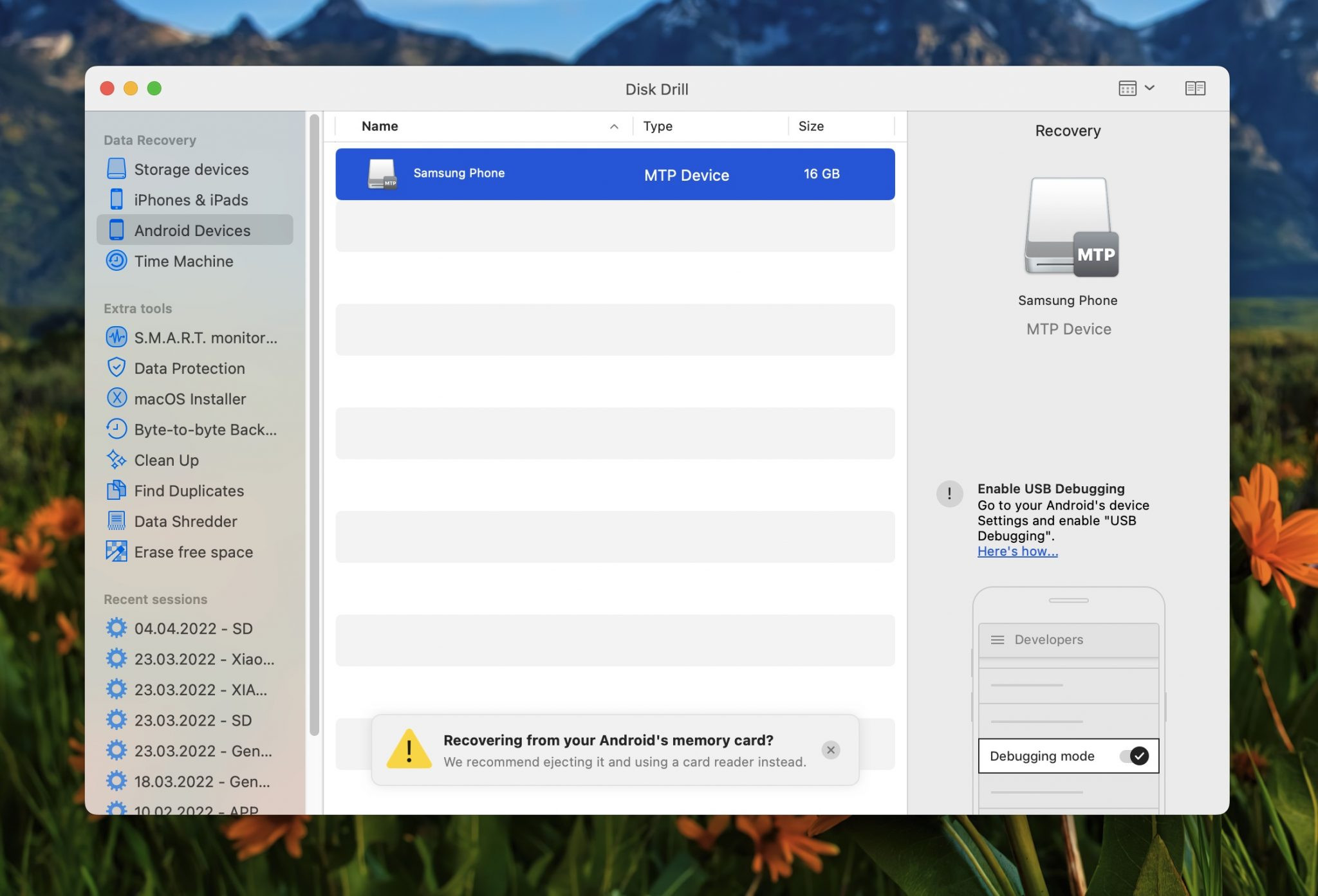 Scanning Samsung phone for deleted photos using Disk Drill
Scanning Samsung phone for deleted photos using Disk Drill -
Once the scan is complete, Disk Drill will display a list of recoverable files. Use the Preview feature to view the photos before recovery. Select the photos you want to recover by checking the boxes next to them.
-
Click the Recover button. Disk Drill will prompt you to choose a recovery destination folder on your Mac to save the recovered photos. Choose a location different from your Samsung phone to avoid overwriting data. Click Recover again to start the photo recovery process.
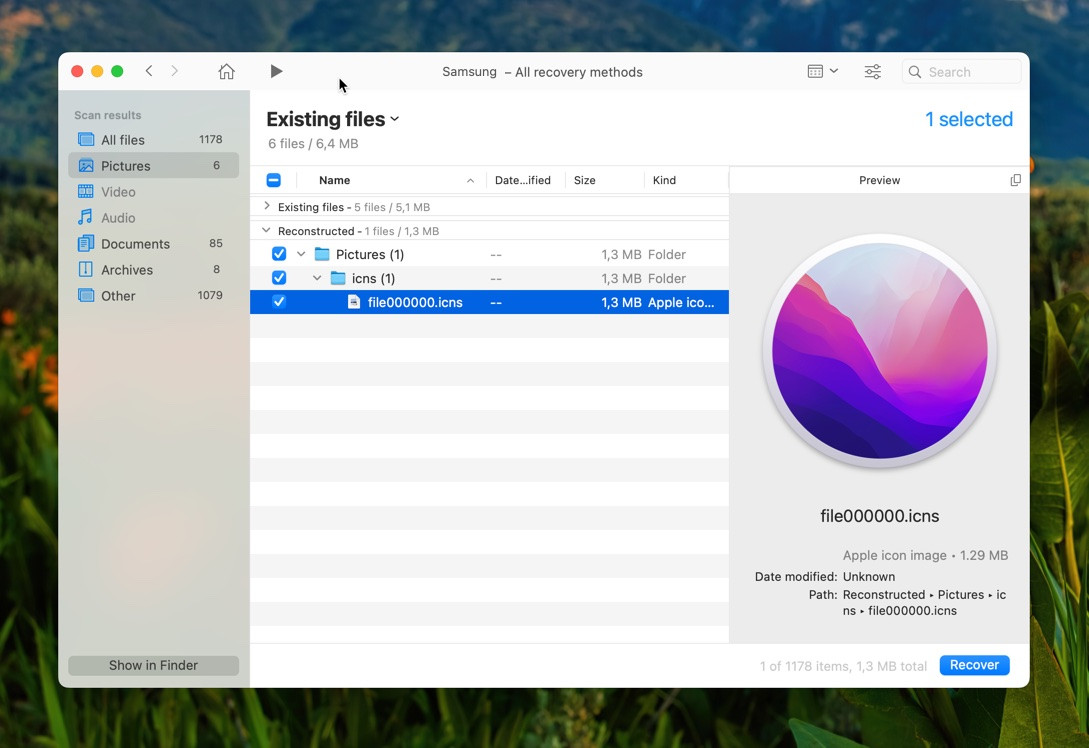 Recovering deleted Samsung photos using Disk Drill on Mac
Recovering deleted Samsung photos using Disk Drill on Mac
Method 2: Using Photo Recovery Software for Windows (Disk Drill for Windows and SD Card Recovery)
While Disk Drill for Windows cannot directly recover data from Android internal memory, it’s excellent for recovering photos from Samsung phone SD cards.
Steps to recover deleted photos from a Samsung SD card using Disk Drill for Windows:
- Download and install Disk Drill for Windows.
- Power off your Samsung phone and carefully remove the SD card. Insert the SD card into a memory card reader and connect the reader to your Windows PC.
- Launch Disk Drill for Windows. Disk Drill will detect your SD card as a removable drive. Select the SD card and click the Search for lost data button next to it. Disk Drill will scan the SD card for recoverable photos.
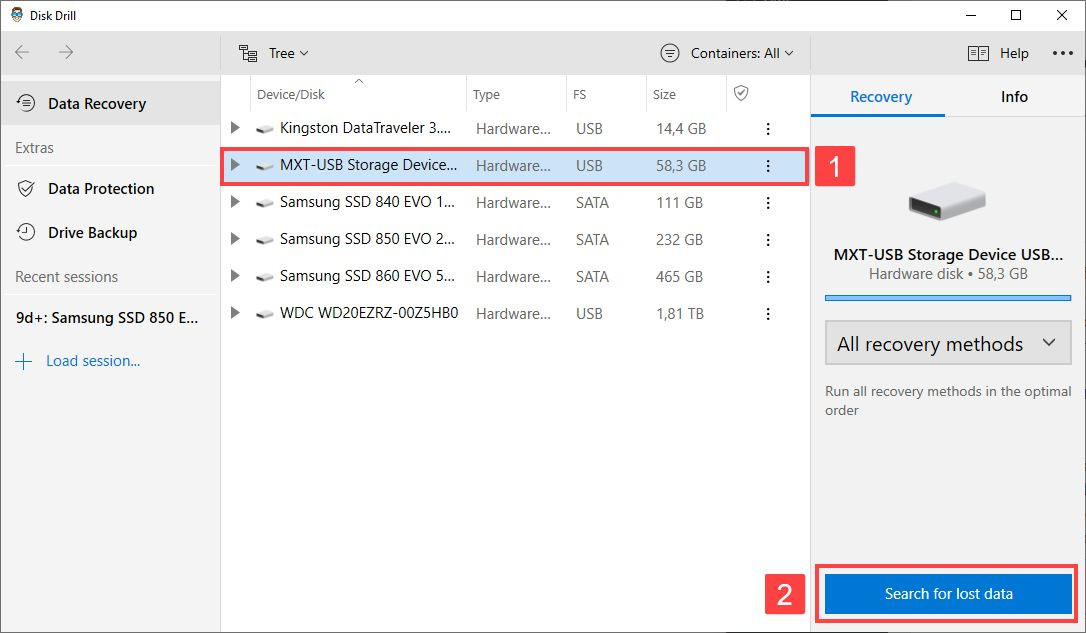 Selecting Samsung SD card for recovery in Disk Drill Windows
Selecting Samsung SD card for recovery in Disk Drill Windows - After the scan, Disk Drill will display the found files. Use the Preview feature to preview the photos. Select the photos you want to recover.
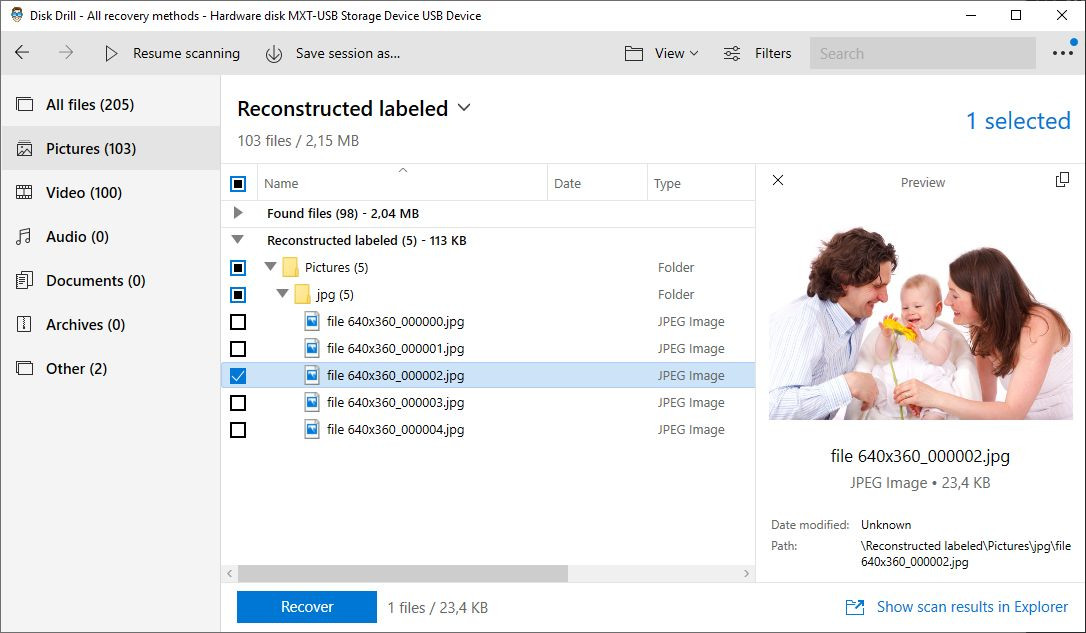 Previewing recoverable photos from Samsung SD card in Disk Drill Windows
Previewing recoverable photos from Samsung SD card in Disk Drill Windows - Click the Recover button. Choose a recovery destination folder on your Windows PC (not the SD card itself). Click OK to begin the recovery process.
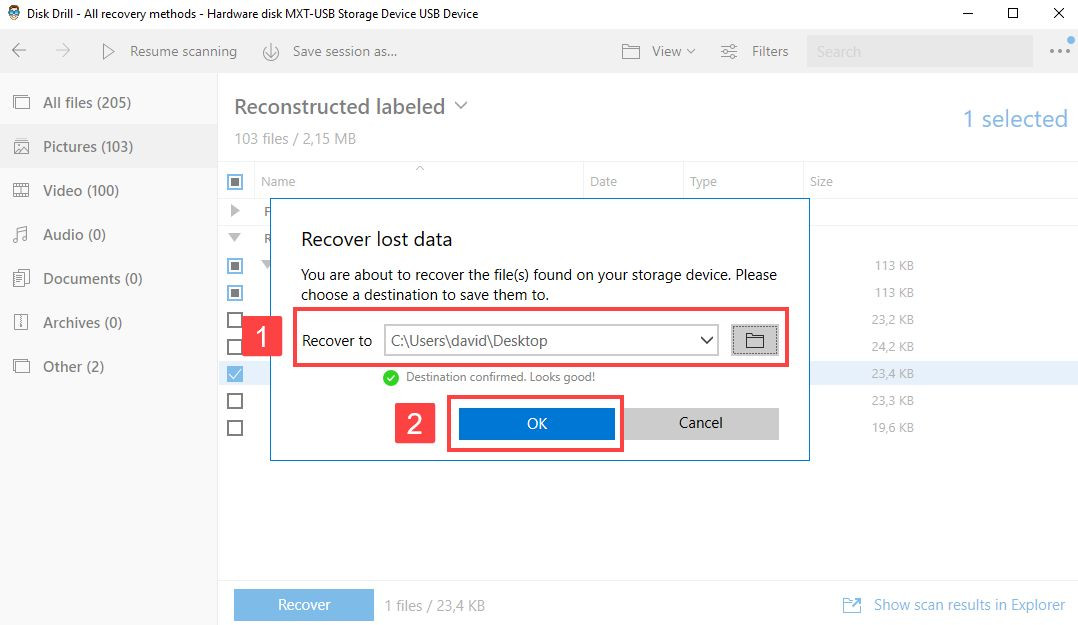 Choosing recovery destination for Samsung SD card photos in Disk Drill Windows
Choosing recovery destination for Samsung SD card photos in Disk Drill Windows
Alternative for Windows Internal Memory Recovery: Wondershare Dr.Fone (Third-Party Option)
If you need to recover photos directly from your Samsung phone’s internal memory on Windows, consider third-party software like Wondershare dr.fone for Android. Dr.Fone claims to support data recovery from a wide range of Android devices, including Samsung models. Research and use such tools with caution and ensure they are from reputable sources.
Recovering Deleted Photos from Samsung Using an Android App (DiskDigger)
For on-device recovery without a computer, you can use Android photo recovery apps. DiskDigger is a popular and effective app for recovering photos and videos directly on your Samsung Galaxy phone. The basic version can recover photos and videos, while the Pro version offers more advanced features and file format support.
Steps to recover deleted photos using DiskDigger on Samsung phone:
- Download and install DiskDigger from the Google Play Store. Search for “DiskDigger” in the Play Store app.
- Open the DiskDigger app and tap the Start Basic Photo Scan button. DiskDigger will begin scanning your phone’s storage for recoverable photos. For a deeper scan, especially of internal memory, rooted access may improve results.
- DiskDigger will display thumbnails of found photos as it scans. Select the photos you want to recover by checking the boxes next to them.
- Tap the Recover button (diskette icon) at the bottom of the screen.
- Choose a recovery option. DiskDigger offers options to save recovered files to a folder on your device, upload them to cloud storage (like Dropbox or Google Drive), or transfer them via FTP. Select your preferred method and follow the prompts to complete the recovery.
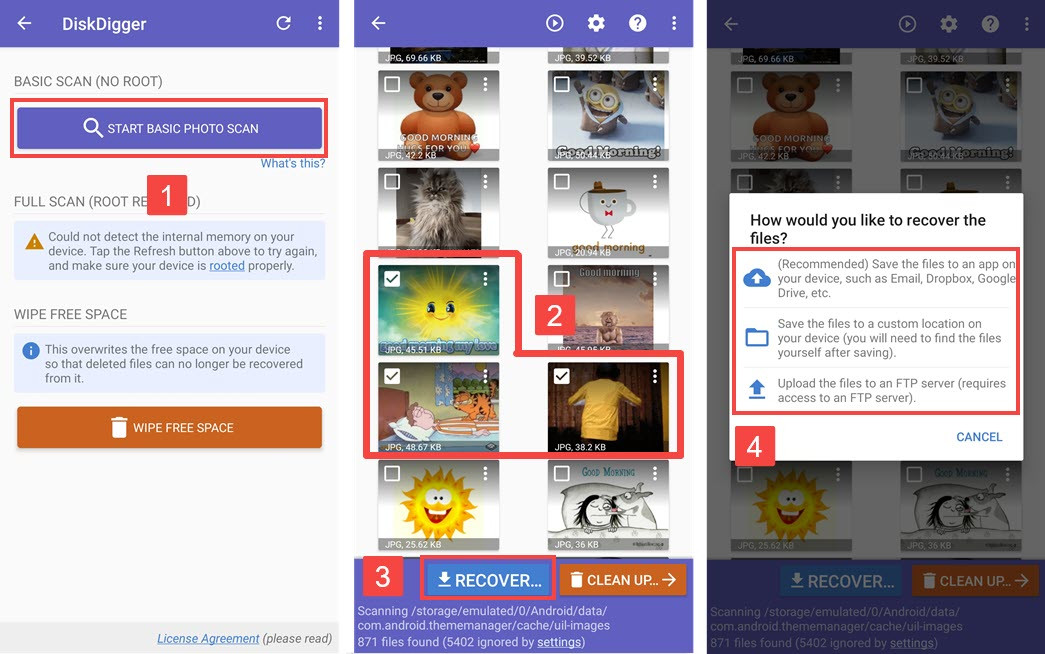 Recovering deleted photos on Samsung phone using DiskDigger Android app
Recovering deleted photos on Samsung phone using DiskDigger Android app
Preventing Future Photo Loss on Your Samsung Galaxy
While photo recovery is often possible, it’s always best to prevent data loss in the first place. Implementing proactive measures can save you from the stress and effort of recovery in the future.
Essential Tips to Avoid Photo Loss on Samsung:
- Regularly sync your Samsung phone with your computer. Use Samsung’s software (like Samsung Flow, if compatible, or simply USB file transfer) to regularly copy photos from your phone to your computer. This creates a local backup and ensures your photos are safe even if something happens to your phone.
- Utilize a memory card for photo backups. If your Samsung phone has an SD card slot, use it! Set your camera to save photos to the SD card. This provides a portable backup – if your phone is damaged, you can likely retrieve the SD card and access your photos from another device.
- Enable automatic phone backups. Android’s built-in backup feature (Settings > Backup & reset > Backup account) can automatically back up your data, including app data and potentially photos (depending on settings), to Google Drive. Ensure this is enabled for a system-level backup.
- Actively back up photos to the cloud. Choose a cloud storage service (Samsung Cloud, Google Photos, Dropbox, OneDrive, Mega, etc.) and enable automatic photo backups. Cloud backups offer offsite protection – even if your phone and computer are lost or damaged, your photos are safe in the cloud and accessible from anywhere.
Summary: Recovering Deleted Samsung Photos
Samsung Galaxy users have several effective methods to recover deleted photos. From cloud backups and the Recycle bin to specialized recovery software and Android apps, there’s a solution for various data loss scenarios. Services like Samsung Cloud and Google Photos provide easy recovery if backups were enabled. For permanently deleted photos or recovery from SD cards, tools like Disk Drill and DiskDigger are powerful options.
Act promptly when you realize photos are missing, as the chances of successful recovery diminish over time. And most importantly, implement preventative backup strategies to safeguard your precious memories from future loss.
Read also:
- Free Ways to Recover Deleted Photos from SD Card
- Recover Deleted Photos from Canon Camera
- Ways to Recover Deleted Photos from an iPhone
- How to Recover Deleted Photos on Different Devices
FAQ
[
How do I recover permanently deleted photos from my Samsung?
](#collapse-item-1)
To recover permanently deleted photos from your Samsung phone, use a photo recovery application like Disk Drill for Mac.
- Download and install Disk Drill.
- Connect your Samsung Galaxy phone to your Mac via USB and allow Disk Drill full access. Your phone may need to be rooted for optimal recovery from internal memory.
- Launch Disk Drill and click Search for lost data to scan for permanently deleted photos.
- Preview the found photos and select those you want to recover.
- Click Recover and choose a save location on your Mac.
[
Can I retrieve deleted photos on Samsung without cloud backup?
](#collapse-item-2)
Yes, you can retrieve deleted photos on Samsung even without cloud backups. Check the Recycle bin in the Gallery app first for recently deleted photos. If they are not there, use photo recovery software like Disk Drill or an Android app like DiskDigger to scan your phone’s internal memory or SD card for recoverable photos.
[
Where is the recycle bin on a Samsung Galaxy phone?
](#collapse-item-3)
The Recycle bin (or Trash) on Samsung Galaxy devices is located within the Gallery app. To access it, tap the three-dot menu in the Pictures tab of the Gallery app and select Recycle bin. Photos remain in the Recycle bin for up to 30 days before being permanently deleted.
[
How can I retrieve deleted photos from my Samsung phone without a computer?
](#collapse-item-4)
You can retrieve deleted photos from your Samsung phone without a computer using the Samsung Cloud backup service, if you had backups enabled. Access Samsung Cloud via a web browser on another phone or tablet:
- Open the Samsung Cloud website in a browser and log in.
- Select Gallery.
- Choose the photos you want to recover, or select All.
- Click the Download icon to download the photos.
Alternatively, you can use an Android photo recovery app like DiskDigger directly on your Samsung phone to scan for and recover deleted photos without a computer.
[
Where do deleted photos go on Samsung before permanent deletion?
](#collapse-item-5)
When you delete photos in the Samsung Gallery app, they are moved to the Recycle bin (or Trash) within the Gallery app. They remain in the Recycle bin for 15 or 30 days (depending on your device and software version) before being permanently deleted from your device.
